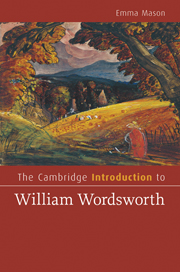Chapter 5 - Critical reception
Published online by Cambridge University Press: 05 June 2012
Summary
Since the publication of the Lyrical Ballads, critics have sought to interpret, decode, unravel, mythologize and attack Wordsworth's poetry and prose. While early critics seemed uncertain about his poetry, the Victorians regarded Wordsworth's voice as confident and prophetic, a view dismantled by modern critics who prefer to read his poetry as anxious or deliberately imprecise. As Wordsworth reminds us, however, thinking is never linear or chronological, and the critical reception of his work can only be suggestively demarcated, biographic work blurring into phenomenological and psychological readings, as political and historicist interpretation catalyse the new prosody and ethical criticism. Modern readers have the advantage of drawing on the now complete Cornell edition as well as numerous searchable electronic databases, and yet, as the variety of readings discussed here attest, Wordsworth's work is notoriously difficult to label.
The uncertain meaning of this work, however, lends it an absorbing fragility that demands a reflective and attentive criticism: as Geoffrey Hartman asserts, we ‘understand Wordsworth best when we are too near ourselves, too naked in our self-consciousness’. Biographical explorations of Wordsworth by Mary Moorman, Stephen Gill, Juliet Barker, Keith Hanley and Duncan Wu (and of his sister by Pamela Woof and Frances Wilson) offer us several routes into the poet's life, and critics like Lucy Newlyn highlight the complexities inherent in Wordsworth's psychological being. Where some readers, like Bernard Groom, find patterns and unity in the poetry, others such as Frances Ferguson see a flawed, complex and vulnerable writer.
- Type
- Chapter
- Information
- The Cambridge Introduction to William Wordsworth , pp. 98 - 110Publisher: Cambridge University PressPrint publication year: 2010

